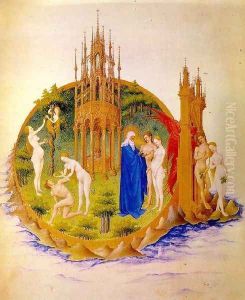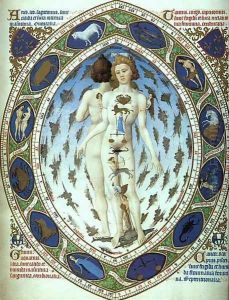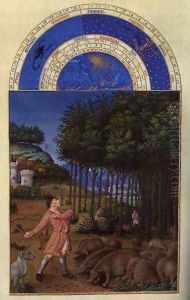Limbourg Brothers Paintings
The Limbourg Brothers, also known as the brothers Paul, Jean, and Herman de Limbourg, were famous Dutch miniature painters from the city of Nijmegen in the Duchy of Guelders (present-day Netherlands). They are best known for their richly illuminated manuscripts of the late Middle Ages, particularly the 'Très Riches Heures du Duc de Berry'. Their exact birth dates are not known, but they were active in the late 14th and early 15th centuries. The brothers were born to a family of artists; their father was a wood sculptor, and their uncle was a painter.
The Limbourg brothers began their artistic training under their uncle in Paris. However, their uncle's death in 1396 and subsequent events led them to the court of Philip the Bold, Duke of Burgundy. It was in Burgundy that they were introduced to Jean de France, Duc de Berry, who became their patron. The Duc de Berry was a passionate art collector and one of the wealthiest men in Europe, providing the brothers with the opportunity to create their most famous works.
The most notable of their creations is the 'Très Riches Heures du Duc de Berry', which is considered one of the masterpieces of Northern Renaissance art. This book of hours contains a calendar with illustrations for each month, each depicting seasonal activities of the nobility and peasantry. Their work is characterized by a remarkable attention to detail, a vivid use of color, and a pioneering use of naturalistic landscape and perspective, which were innovative for the standards of the time.
Unfortunately, the brothers' lives were cut short by an epidemic in 1416, which killed Jean, Duc de Berry, and the three Limbourg brothers. They died before they could complete the 'Très Riches Heures', which was later finished by other artists. Despite their premature deaths, the Limbourg Brothers' contribution to the art of manuscript illumination had a lasting impact on the Northern Renaissance and on the development of early Netherlandish painting.


